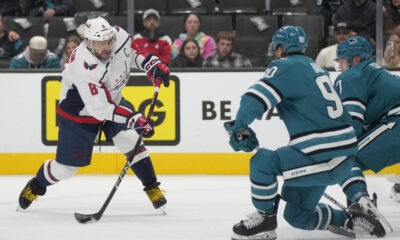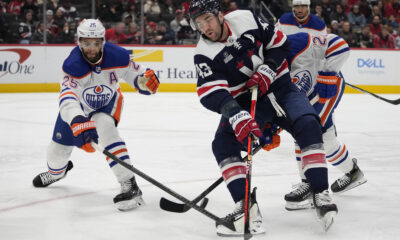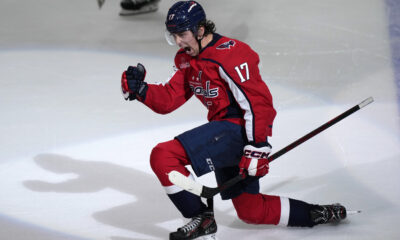Capitals Features
John Carlson Details Slapshot To Face, Extent Of Injury & Going Into ‘Survival’ Mode
Washington Capitals defenseman John Carlson opens up about taking a slapshot to the face, the extent of the injury after suffering a fractured skull and severed temporal artery and his recovery timeline.
ARLINGTON, V.A. — In a flash, John Carlson saw his life flash before his eyes.
The Washington Capitals' Dec. 23 showdown with the Winnipeg Jets had been a routine game for Carlson, one filled with history as captain Alex Ovechkin tied Gordie Howe for the second-most goals in NHL history in the first period and looked to pass him in the final minutes of the third. He was lined up for a defensive zone draw, ready to try and protect his team's two-goal lead and get things going for Ovechkin up ice. The puck dropped, and Carlson went to the slot, where he saw former teammate Brenden Dillon tee up for a one-time blast from the point.
There was no time to react. Dillon's 90 MPH slapshot went straight into Carlson's head, sending him hard to the ice. Capital One Arena went silent as Carlson's teammates went into a panic, and the bench jumped up to take action.
"Can you get out of the way of a puck? I don't know… I guess you don't really think about it when there isn't much [you could've done]," Carlson said. "In situations like this, at least you don't have to."
Carlson didn't black out or lose consciousness, but there was pain. Pain that there wasn't really time for him to acknowledge because he couldn't see. All that he could make out was red, as blood from the impact flooded his visor, leaked onto his jersey and pooled onto the ice.
The culprit behind the heavy bleeding was a fractured skull and severed temporal artery, one of the major arteries in the head that supplies blood to the muscle, skin and more near the forehead.
"That was all the blood and stuff that was, at the time, the scarier — it still is, I guess — but the scarier of anything that happened," Carlson said, pointing to the side of his head where the puck did its damage. "Just all the blood and everything. Whenever you see you know, that blood, you get a little weary of what's happening and stuff. I'm sure I lost a little bit that day. They do say you get a lot of blood to the brain, so that's a good thing for me in the moment."
Carlson's instincts kicked in as he grabbed at his face, and Ovechkin and Dylan Strome got him to the bench as fast as possible as blood leaked out onto the ice. Erik Gustafsson had gone to grab him a towel, and the trainers immediately followed No. 74 down the tunnel to address the situation quickly.
"It was kind of survival-ish," he said of his mentality. "I was just kind of… when you see blood, you're just like, 'What do I have to do to get out of here?' That's what I was feeling like. Even in the moment, you don't think about the pain as much. Just what you think is the best thing to do."

After Jason Serbus and the medical team stopped the bleeding — the biggest concern with any open wound — Carlson was put on a stretcher and transported by ambulance to the closest MedStar facility: MedStar Washington Hospital Center. He underwent numerous tests before being discharged on Christmas Eve. He was never diagnosed with a concussion, but the recovery process was the same. The only way to recover was with rest, time and pain management.
A frustrating waiting game would ensue, but there was optimism and hope as Carlson was given the news that he would be okay and that he would be able to skate again.
"I haven't had this much time off in my life, probably," Carlson said, adding, "The majority of injuries longer in nature are kind of the freakier, the things you can't control: I broke my ankle, or people break their wrists or they block a shot and bust their knee. Most of the injuries, the soft tissue stuff is more… that's just all things that you can't really control."
The mental toll weighed even more when he watched the Capitals start to spiral, as the team suffered numerous inconsistencies and dropped critical games that led to them falling out of playoff position. In that situation, Carlson couldn't control anything, as he had to just focus on his own progress.
"When things aren't going the way you expect them to, and certainly when you're not playing, it's really difficult… it's tough emotionally to see how hard they're battling and see how things are going," Carlson said, adding, "Me not playing and coming in and tailor-making whatever I'm doing every day and how I feel and all that is fine-tuned, and their [day] is show up and deal with everything that's going on. It's difficult being on the outside."
After time at home with his wife and three sons, Carlson was then allowed to start light workouts, and eventually, he worked his way back onto the ice, skating early in the morning with coach Wendy Marco. Still, there were mental hurdles to overcome, especially as he watched his team struggle and suffer numerous inconsistencies that led to them falling out of playoff position without him in the mix.
"I think early on, you're real tentative. You start out kind of on your own, too, so you don’t really think about anything because everything you can control is pretty simple to deal with, I would say. But you’re introducing other guys throughout this time, other guys were practicing with me here or there and what have you, and you added more pucks, you added more bodies, more chaos and certainly those things come up, and you have to find a way to deal with them and work through them in the proper manner because I know there’s one thing in this league: you can’t be hesitant about anything and you certainly can’t let yourself back on the ice if you’re in a real situation, if you’re dealing with stuff. It just doesn’t work like that.”
Carlson was getting more work in with Wendy Marco this morning. pic.twitter.com/rGCVyqlAT8
— Sammi Silber (@sammisilber) February 22, 2023
Now, with less than a month to go and 12 games left on the regular-season circuit, Carlson is back to practicing with his teammates daily. He is in a non-contact jersey, though there is a plan to upgrade soon. There's no exact return date in place, though his upgrade to a contact jersey could come soon as his recovery has gone according to plan with him turning up the intensity on a daily basis. All that he needs now is medical clearance, and when that happens, he expects to play regardless of what the standings situation is.
Still, for the 33-year-old, his health and being fully cleared is the most important thing.
"My expectation to play is based off of putting myself in no harm right now versus in a year from now and next September and two Septembers from now and five Septembers from now. I think I’m not coming back if there’s a risk of anything," Carlson said. "So whether that is now or in five years, that’s when I’ll be back.
"This is kind of a tough time of year to come back to because like I talked about, that mental strain, what these guys have been dealing with day in and day out, backs against the wall kind of feelings, there’s a lot of that going on in the room right now, too," he added. "So as much as it would be great for me to practice for an hour, if I could handpick and do that every single day, that’s what would be best for me, but that’s not what’s best for anyone else.”
Right now, though, Carlson said he's feeling the best he has in months and is not experiencing any lingering headaches or aftereffects. Regarding the injury, he's done asking "what if," and ultimately, he's just grateful that he can continue his career, no matter how long his return comes from now.
"I feel really good. Feel rejuvenated," he said, adding, "Just try to take care of myself, get better and do things that I otherwise wouldn't do and get ready to come back."












